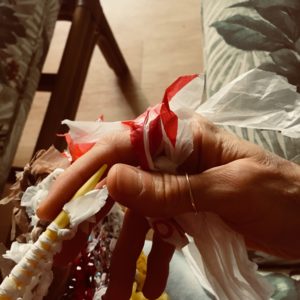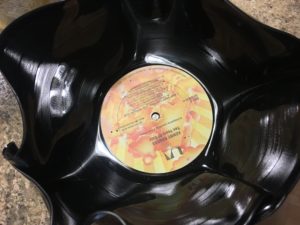This Plastic Casing of My Body, An Art
This Plastic Casing of My Body, An Art
by Emily Bowles
My femaleness has always had hard edges.
 I collected Barbies and built walls around myself, boxes like the Dreamhouse that took up so much space in my room, plastic walls with sharp corners, fixed surroundings, flowers cut to look like the ones growing by my next-door neighbor’s mailbox but so much less fragile.
I collected Barbies and built walls around myself, boxes like the Dreamhouse that took up so much space in my room, plastic walls with sharp corners, fixed surroundings, flowers cut to look like the ones growing by my next-door neighbor’s mailbox but so much less fragile.
So much less fragile.
The architecture of plastic promised that: a permanence and a relief from the softness, the easy-to-hurtness of being a girl and then a woman, I thought. Plastic offered protection (lessons learned later about latex gloves, condoms, barriers designed to stop fluidity—a lovely thought when it comes to blood, to semen). Plastic prevented me from feeling… anything.
This is what I learned when I read Donna Haraway’s A Manifesto for Cyborgs: there is power in abnegating femaleness, in living between body and machine. At the same time, we experience technological waste—that’s something that ecofeminists addressed before Haraway in their paralleling of the female body with the natural world, and that even in a post-human dystopia, structure is ineluctable.
 I read Lidia Yuknavitch’s The Book of Joan and Kaethe Schwehn’s The Rending and the Nesta round the same time one of my friends introduced me to plarn. This coincidental juxtaposition, happening as it did during Plastic-Free July and my second viewing of A Plastic Ocean, has made me think about what I have done to my body, what I have done to the earth, and what I make, how it makes and unmakes me, strips of plastic bags pulled tight by plastic needles and sloping loosely from a ball I’ve made over my fingers.
I read Lidia Yuknavitch’s The Book of Joan and Kaethe Schwehn’s The Rending and the Nesta round the same time one of my friends introduced me to plarn. This coincidental juxtaposition, happening as it did during Plastic-Free July and my second viewing of A Plastic Ocean, has made me think about what I have done to my body, what I have done to the earth, and what I make, how it makes and unmakes me, strips of plastic bags pulled tight by plastic needles and sloping loosely from a ball I’ve made over my fingers.
I hate it.
I am making bags out of bags, a metaphor and a reality that is as tangled as the piles of trash I’m pulling together, weaving together to keep myself from falling apart at the seams, to keep my tiny fragment of the world from being filled up with so much waste.
Working with plastic has taught me how frail the substance feels when it has outlived its first use, and I feel sorry for it, sorry for this flimsy substance that falls apart in my hands. I try to make it sturdy, even as I curse it for making me feel dirty (perhaps I should have rinsed off the CAUTION DANGER tape I tore off a cone by a construction site before I began to touch it, finger to needle), culpable for all the things I have thrown away.
 The things I have thrown away. The times I have thrown myself away—on men, on meaning, and on meaninglessness. I have been an object, the object, which makes it hard to object. I have been treated as disposable. I have treated myself as disposable, I think, as I imagine the number of wastebaskets by body has filled with tampon applicators, bottled water, Ziploc bags, lip-gloss tubes, mascara wands, plastic hangers from clothes I ended up not wanting.
The things I have thrown away. The times I have thrown myself away—on men, on meaning, and on meaninglessness. I have been an object, the object, which makes it hard to object. I have been treated as disposable. I have treated myself as disposable, I think, as I imagine the number of wastebaskets by body has filled with tampon applicators, bottled water, Ziploc bags, lip-gloss tubes, mascara wands, plastic hangers from clothes I ended up not wanting.
It is so easy to consume and be consumed in ways that surreptitiously make us feel unworthy, as if we’re made of the stuff that fills so many trash cans and recycling bins. We live in a culture where we want women to look like plastic, to feel like plastic—and to be as easy to dispose of as plastic. Maybe that’s why, as much as I hate it, I’m drawn to the fact that it outlives us, chokes out everything we have stereotypically labeled feminine: water, birth. This so-called disposable product is destined to outlive us.
 My disposable body, the body I keep trying to throw away (babies and bathwater seems like the appropriate phrase here) keeps returning. I choke on it like a sea otter or baby seagull stuffed full of trash bags. I choke on it and still float. I am learning that what we view as disposable is in fact not something we should toss without thinking into a receptacle, not something we should put off to the side and pretend never existed. It’s the stuff that matters.
My disposable body, the body I keep trying to throw away (babies and bathwater seems like the appropriate phrase here) keeps returning. I choke on it like a sea otter or baby seagull stuffed full of trash bags. I choke on it and still float. I am learning that what we view as disposable is in fact not something we should toss without thinking into a receptacle, not something we should put off to the side and pretend never existed. It’s the stuff that matters.
Each ball of plarn, each broken Barbie, and every vinyl record I’d rather melt down than hear out has a story. For example:
The edges of my femaleness have hardened. The landfill of my living room is a series of landmines that I stitch together to create something capable of withstanding the right pressures to tell a different version of sustainability that defies fictions and fibers. I hope.
Plastic is a gift, and I have made the most of Barbies, vinyl albums, and plastic bags by remaking them, lending them a permanence and a new intelligibility.
Plastic is a prison. It ties me to social constructions and reminds me with every stitch how many molecules are fighting for meaning, for space—and how much ends up floating away, causing destruction, rendering itself obsolete and yet unavoidable.
When plastic moves down my arms and I grip it, I am part woman, part object, always.
The domestic depends on it. Grocery bags, Ziploc bags, microwavable containers. It’s no wonder that when people try to go Zero Waste, they have to start in the kitchen and work their way out. How often do we work our way out?
What I make unmakes a small story of destruction. What I use helps, I tell myself, create a tiny bit more space for life in the ocean, for life in our most vulnerable communities, the ones right on the edge of landfills.
On my arms, the plastic feels toxic, not like the living fibers I love to knit.
With it, I am never sure if I am reproducing artifice or unmaking it (e.g., when I told a man that I was making a bag from bags, he perhaps predictably laughed, even though it wasn’t intended to be funny).
We give birth to stories that are objects, too—stories and objects we do not always want to touch and to touch us.
Knitting with plastic has its own kinesthetics. My mother could hear me knitting when I talked to her on the phone. There is, in that, a sensory power and a shifting away from the quietude of crafts toward something more radical.
It’s new and old at once, this repurposing.

About the Maker
Emily Bowles is a writer, advocate, and non-profit management professional whose life was either ruined or saved by watching The Last Unicorn and reading Wuthering Heights too many times. She inherited her love of knitting magical creatures from her grandmother, whose sock monkeys were legendary, and her great aunt, whose quilts told many stories. Emily’s first chapbook, His Journal, My Stella (Finishing Line Press), draws on the research she did as a graduate student on Jonathan Swift and uses it as a framework to tell her own stories of sexual violence and shame. Read more of her poetry online at embowlden.blogspot.com and follow her on Instagram @embowlden77.
Top photo by Markus Spiske on Unsplash

Recent Comments